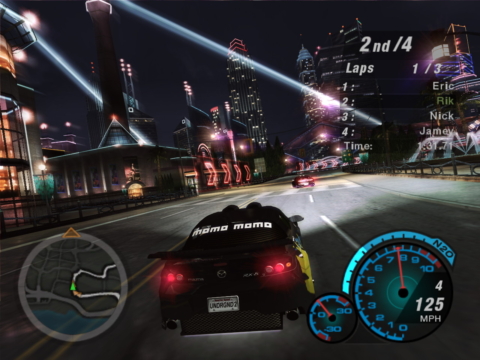
Need for Speed: Underground 2
Written by: Rik
Date posted: January 1, 2018
- Genre: Racing
- Developed by: EA Black Box
- Published by: Electronic Arts
- Year released: 2004
- Our score: 7
Although it might not have been immediately obvious from my rather glib write-up, I rather liked Need for Speed: Underground. Beyond being simply the shot in the arm that the series desperately needed, and a building block towards the one of the best NFS games, Most Wanted, it was also a rather fine racer in its own right. As for this one, I’m not quite sure why I ignored it up until now, beyond a sense that it was simply more of the same – a placeholder before new elements were added for Most Wanted – and, given that one of the drawbacks of the original Underground was an element of repetitiveness, the prospect of ploughing through another 100+ races didn’t really appeal.
The major development since Underground is the introduction of a free-drive element: the city of Bayview, which you can roam around at your leisure. Where in UG, you simply chose the next race from a menu, in UG2, you’ll need to look at the map and drive to it. Unlike in later offerings, which wisely offered the option of doing this or simply skipping to the race by clicking on the map, here you’ll have to drive yourself each and every time. It’s mildly tedious, to say the least: although the handling is satisfying enough and encourages some irresponsible twatting around with liberal use of the handbrake, you won’t find yourself enjoying a drive from A to B in the way you might in, say, Test Drive Unlimited, while the absence of police means that you won’t initiate any chase-based hi-jinks either.
What you can do, though, is encounter AI street racers and challenge them to a one-off ‘Outrun’ race (later seen in 2008’s Undercover), in which victory is attained by putting a significant distance between you and your opponent. Victory brings a small cash reward, and stringing enough together brings the opportunity to secure visual and performance upgrades that wouldn’t otherwise be available. This free-roaming element kind of reminds me of Tokyo Xtreme Racer on the PS2, although here it’s very much an optional sideshow rather than the meat of the game. Other incentives for exploring the city include discovering the locations of the various garages and shops you’ll need to visit in order to purchase cars and upgrades, and also finding secret races which aren’t shown on the map.
Bayview isn’t really the sort of place you want to look around: it’s a kind of hideous conglomeration of a number of US cities, and notable landmarks are in short supply. The main things that do catch the eye are adverts for real-life brands, which isn’t unusual in itself, although some of the choices are a little bizarre: Burger King, Old Spice and Campbell’s Soup don’t seem like great matches for a street racing game, but they’re particularly prominent here, so much so that when one of your racer buddies calls you up to give you a vague clue about the location of a so-called ‘secret’ race (“yo, I heard they’re by the hotel plaza!”) you sort of wish he’d say it’s near the Burger King, because at least you’d know where that is. Although that would be horrible. Just like eating at Burger King, in fact.
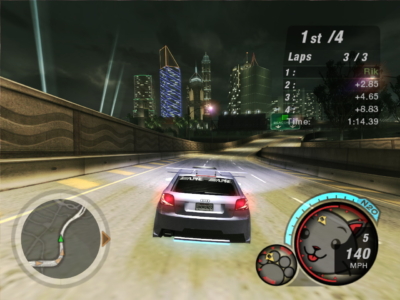
For all the general gaudiness, there are some visually appealing moments, if you like night-time cityscapes. (Don’t ask me why I got that cat-based custom speedometer, though).
Aside from all that, it’s the familiar street-racing story: you used to be the best, but then something bad happened which means you have to start all over again in a Ford Focus. After competing in hundreds of races, trading in and upgrading your car along the way, you’ll eventually come face to face with the same scoundrel who did the bad thing to you, and secure revenge by beating him in a final duel. The plot, such as it is, is relayed to you in a graphic novel style, which works well enough, although I do have a soft spot for the campy video sequences of later Black Box NFS games. Fulfilling the role of the player’s friendly advisor is actor-slash-model Brooke Burke, who plays Rachel Teller. She’ll tell-er you (sorry) all about how to max out your dope ride and get respect on the streets! (A thousand more apologies).
As for the races themselves, they come in various flavours: returning from Underground are the lap-based Circuit, point-to-point Sprint, straight-line Drag and twisty-turny Drift. New are Street-X and Underground Racing League (URL), both of which are lap races but take the action off the streets, removing traffic from the equation. Street-X places the emphasis on tight corners and removes the ability to use nitrous, and is a great addition, while URL takes the action onto more traditional tracks, and can be a bit tedious at times (although the URL races at the airport are pretty good).
Drift races have been improved by the addition of an on-road, downhill version, with the traffic providing an extra element of challenge, while the Drag races don’t seem to quite have the same intensity this time around: they seem too long, and success is less about the timing of gear shifts and hitting the nitrous than dodging obstacles and making use of the new mechanic that allows you to top-up your stocks of nitrous by drafting closely behind an opposing vehicle. (This also extends to other races where nitrous is permitted – you earn more nitrous, Burnout-style, by drafting, power-sliding or narrowly avoiding collisions).
Need for Speed was always about driving cars that you’d feel like a dickhead for driving in real-life, be it the high-end supercars of the earlier games, or the kind of souped-up violation of the senses that we see here. Sadly, a key component of career progress here, beyond winning races, is that your car looks as monstrous as possible. In this respect, Underground 2 goes further than its predecessor’s spoilers, vinyls and neon, adding speciality parts such as spinning hubcaps, hydraulics and custom doors. Like it or not, you will need to make use of all of these parts to get your vehicle’s visual star rating up and attract the attention of specialist magazine photographers and DVD producers. Put simply, there’s no way to have a car that is just mildly gaudy, you have to go full-on. (Incidentally, if at any point you find yourself ‘stuck’ with no more races available on the map, it’s likely that there’s still some stuff out there that you need to have welded to your vehicle but haven’t). By the end of the game, my 10* car looked like it was ready to fight Robocop, and I took a certain amount of pleasure in abandoning it for a more low-key effort during the game’s final stages.
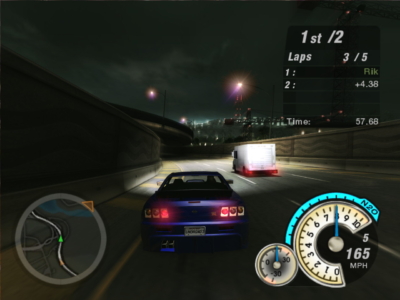
The innocuous white van from Underground returns – ready to block a tunnel or unexpectedly cause you to crash whenever you least expect it.
Another thread that runs through all Need for Speed games, going right back to the City stages of the very first one, is that the series is at its best when you’re driving quite quickly on public roads, weaving through traffic and negotiating gentle corners. The worst bits of Need for Speed games, going back to the Alpine stages of the very first one, have been when the corners get too tight and twisty and your car starts bouncing off the scenery. Underground 2 features some of the latter: a key trick seems to be to put a horrible corner at the end of races, setting up a potential late crash for you and mysterious sudden burst into the lead for your opponents (although the catch-up AI isn’t quite as heinous as in the previous game). But there are also plenty of good moments, and when you get into the rhythm of mastering some races, pulling off a series of corners the right way or nipping through a particularly nifty shortcut, it’s very satisfying.
The main criticism would be that, as with the previous game (and, to be fair, Most Wanted as well) there are a lot of very similar races, and it can be a grind at times. A more diligent retro reviewer would have compiled a proper cross-section of features and differences between the various Black Box NFS games, but I can honestly say that the prospect of playing one after another would drive even the most hardened arcade racing fan insane – thousands of races, interspersed with broadly similar cut-scenes about regaining respect on the streets and all the while receiving around a million virtual voicemail and text messages giving you unsolicited advice. As previously mentioned, though, I do think that I underestimated the original Underground, and there was a certain white-knuckle intensity about that game’s latter stages which is missing here: there’s not a sense of this one building up to anything, it just sort of finishes, after a rather anticlimactic final race.
There is however also a feeling of a series on the up, adding to Underground and moving towards the excellent Most Wanted. Post MW, Black Box seemed to be reduced to recycling features and attempting to reheat past glories, while tinkering with the difficulty level and handling model to no great effect. It’s also true that UG2 adds elements that aren’t of much personal interest to me, but might be to others. We’ve already mentioned the visual tarting up of the cars, but there’s also the opportunity to get down and dirty with tweaking performance: beyond upgrading parts and components, you can adjust suspension and gear ratios and the like. Thankfully, it’s not an essential part of the game (and I don’t think it should be in an arcade racer) but, after a spot of Googling uncovered some ancient forum posts discussing the best cars in the game, it does seems possible to extract some significant performance boosts from otherwise modest vehicles by tuning them up. So, potentially, this is a plus for some people, especially as the series moved away from the import/tuning theme with Most Wanted and beyond.
Overall, then, Underground 2 is a solid and broadly enjoyable entry in the NFS series. As mentioned, there’s been a little too much time between playthroughs of the different games to evaluate them alongside each other in forensic detail. If pushed, though, I’d express a mild preference for its predecessor, although in terms of ambition and features this one has the edge. Of course it’s not as good as Most Wanted, but it is certainly much better than 2008’s Undercover (of which I have relatively recent experience). After that rather underwhelming effort, it was good to be reminded of my affection for the Black Box NFS games, although in a way I was sad to tick off another good one and leave only the weaker entries remaining.

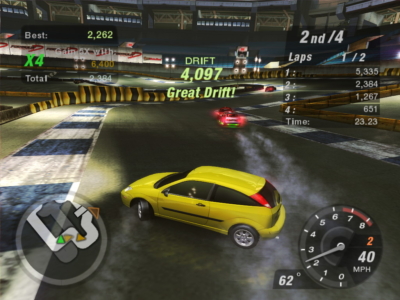
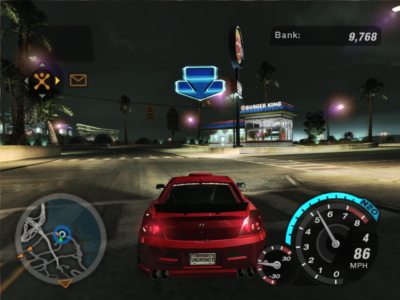
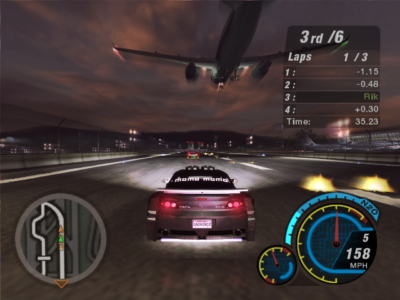

 Posts
Posts
Completely out of subject, but Happy New Year to the both of you and to your site ! May you have good health, and times to appreciate it, and money to enjoy it ! 🙂
January 2, 2018 @ 10:02 am